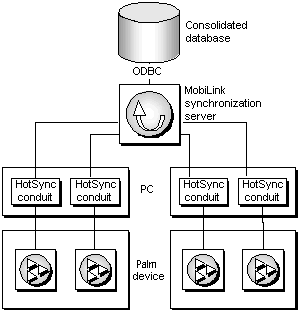







MobiLink Synchronization User's Guide
UltraLite Clients
Synchronizing UltraLite databases on the Palm Computing Platform
UltraLite applications on Palm devices can synchronize over a TCP/IP or HTTP stream, in much the same manner as UltraLite applications on other platforms. They can also synchronize using the Palm-specific HotSync synchronization streams, which operate in a different manner. This section describes the architecture of the HotSync synchronization.
The sequence of events that occur during HotSync synchronization is as follows:
When your UltraLite application is closed, it saves the state of your UltraLite application. The state information is stored in the Palm database, separately from the UltraLite database.
For more information, see Closing an UltraLite Palm application.
When you synchronize your Palm device, HotSync calls the MobiLink conduit to synchronize with the MobiLink synchronization server. The MobiLink conduit reads the pages from the UltraLite database and sends the upload to the MobiLink synchronization server.
The MobiLink synchronization server integrates updates into the consolidated database and sends a download stream to the conduit.
The conduit integrates the download stream into the UltraLite database on the Palm device.
When your application is launched, it loads the previously saved state of your UltraLite application.
For more information, see Launching an UltraLite Palm application.
The following diagram depicts the HotSync architecture. A separate HotSync conduit is required for each application. You can have multiple HotSync conduits on a single PC.

For a description of how to set up your MobiLink HotSync conduit, see Configuring the MobiLink HotSync conduit.



